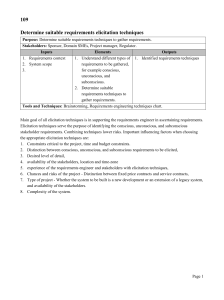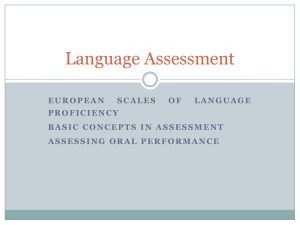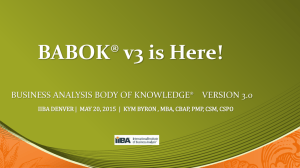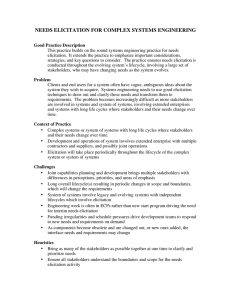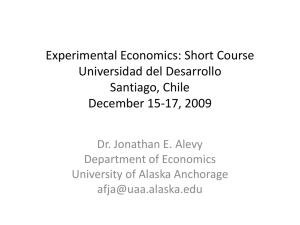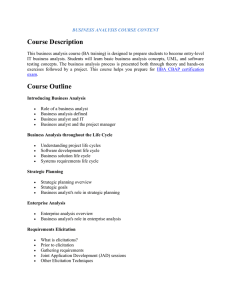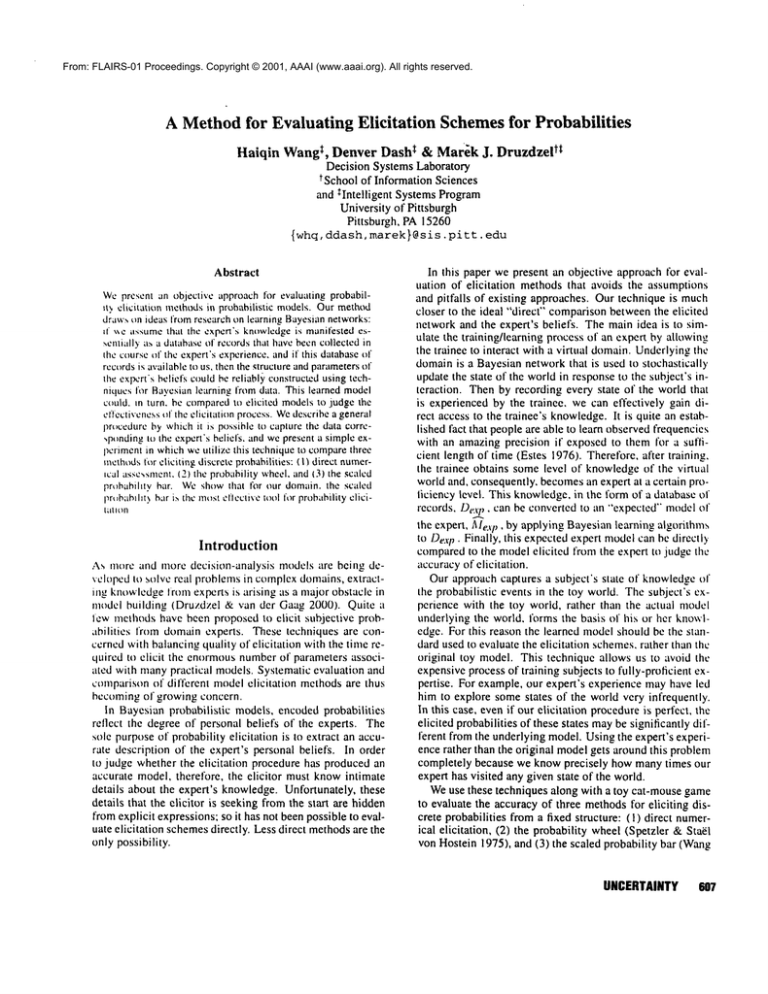
From: FLAIRS-01 Proceedings. Copyright © 2001, AAAI (www.aaai.org). All rights reserved.
A Methodfor Evaluating Elicitation
Haiqin
Schemesfor Probabilities
Wangt,
tt Marek J. Druzdzel
Denver Dash t &
Decision Systems Laboratory
tSchool of Information Sciences
and *Intelligent Systems Program
University of Pittsburgh
Pittsburgh, PA 15260
{whq, ddash, marek}@sis .pitt. edu
Abstract
Wepresent an objective approachfor evaluating probabilit,, clicitati~m methodsin probabilistic models.Our method
draw~,tm ideas from research on learning Bayesiannetworks:
iI ~c assumethat the expert’s knowledgeis manifested es~,cntially a.,, a databaseof recordsthat havebeencollectedin
the course of the expert’s experience,andif this databaseof
recordsis availableIt:, us, then the ~tructureandparametersof
the expert’s beliefs couldbe reliabl)’ constructedusing techniques for Bayesianlearning from data. This learned model
could, mturn. be comparedto elicited modelsto judge the
effectiveness of the clicitation process. Wedescribe a general
pn~ccdurcby whichit is possible to capture the data corre,,ptmdingto the expert’s beliefs, and wepresent a simpleexperimentin whichweutilize this technique to comparethree
methodst~r eliciting discrete prt~babilities: (I) direct numerteal assc,,smcnt. (2) the probability wheel,and(3) the scaled
iwohahihty bar. Weshowthat t’or our domain, the scaled
prub:lhlht}bar i~, the retest eflcctivetool for probabilityclicitdtlOn
Introduction
As more and more decision-analysis models are being developed to solvc real problems in complex domains, extractmg knowledgefrom experts is arising :ts a nlajor obstacle in
model building (Druzdzel & van der Gaag 2000). Quite
few mcthods have been proposed to elicit subjective probabilities from domain experts. These techniques are concorned with balancing quality of elicitation with the time requircd to elicit the enormous number of parameters associated with manypractical models. Systematic evaluation and
comparison of different nlodel elicitation methods are thus
becoming of growing concern.
In Bayesian probabilistic models, encoded probabilities
reflect the degree of personal beliefs of the experts. The
sole purpose of probability elicitation is to extract an accurate description of the expert’s personal beliefs. In order
to judge whether the elicitation procedure has produced an
accurate model, therefore, the elicitor must knowintimate
details about the expert’s knowledge. Unfortunately, these
details that the elicitor is seeking from the start are hidden
from explicit expressions; so it has not been possible to evaluate elicitation schemesdirectly. Less direct methodsare the
only possibility.
In this paper we present an objective approach for evaluation of elicitation methods that avoids the assumptions
and pitfalls of existing approaches. Our technique is much
closer to the ideal "direct" comparison between the elicited
network and the expert’s beliefs. The main idea is to simulate the training/learning process of an expert by allowing.
the trainee to interact with a virtt, al domain.Underlyingthe
domain is a Bayesian network that is used to stochastically
update the state of the world in response to the subject’s interaction. Then by recording every state of the world that
is experienced by the trainee, we can effectively gain direct access to the trainee’s knowledge.It is quite an established fact that people are able to learn observed frequencies
with an amazing precision if exposed to them lbr a suflicient length of time tEstes 1976). Therefore, alter training,
the trainee obtains some level of knowledge of the virtual
world and, consequently, becomesan expert at a certain proliciency level. This knowledge,in the form of a database of
records, D~:~-I.._2, , can be convertedto an "expected"modelof
the expert, AIe.v,, by applying Bayesian learning algorithms
to Dexp¯ Finally, this expected expert model can be directly
compared to the model elicited from the expert to judge the
accuracyof elicitation.
Our approach captures a subject’s state of knowledge of
the probabilistic events in the toy world. The subject’s experience with the toy world, rather than the actual model
underlying the world, forms the basis of his or her knowledge. For this reason the learned model should be the standard used to evaluate the elicitation schemes, rather than the
original toy model. This technique allows us to avoid the
expensive process of training subjects to fully-proficient expertise. For example, our expert’s experience may have led
him to explore some states of the world very infrequently.
In this case, even if our elicitation procedureis perfect, the
elicited probabilities of these states maybe significantly different from the underlying model. Using the expert’s experience rather than the original model gets around this problem
completely because we know precisely how many times our
expert has visited any given state of the world.
Weuse these techniques along with a toy cat-mouse game
to evaluate the accuracy of three methods for eliciting discrete probabilities from a fixed structure: (I) direct numerical elicitation, (2) the probability wheel (Spetzler & StaEl
von Hostein 1975), and (3) the scaled probability bar (Wang
UNCERTAINTY
607
& Druzdzel 2000). We use mean squared errors between the
learned and the elicited probabilities to evaluate the accuracy
of the different methods. Weshow that for our domain, using the scaled probability bar is the most effective and least
time-consumingprocedure for probability elicitation.
In the following sections, we first give a brief review of
the existing evaluation schemes of probability elieitation.
Then we present the assumptions and relevant equations that
allow us to capture a subject’s beliefs in the form of learned
network parameters. Next. we describe the cat-mouse game
that we used to train our subjects and collect data for learning. Finally, we present our experimental design and results
followed by a discussion of our tindings.
Evaluation
Schemes of Probability
Elicitation
Methods
Eliciting probability of a proposition from an expert
amounts to obtaining the expert’s subjective degree of belief in that proposition. There is a vast amountof behavioral
decision theory literature covering this topic. Dt, e to space
limitations, we will not discuss these methodsin this section.
For a detailed review, see for example (Merkhofer 1987:
Morgan & Henrion 1990).
Thedifficulty in evaluating elicitation methodsis that the
true model is needed in order to be comparedto the elicited
model. Obviously, since the former is encapsulated in the
expert’s mind, it is not readily available for comparison.Previous comparisons of elicitation schemes followed essentially three lines of reasoning: (I) expert’s preference. (2)
benchmark unodel, and (3) performance measure.
The first approach, expert’s preference, is based on the
assumption that when an elicitation methodis preferred by
the expert, it will yield better quality estimates. While this
assumption is plausible, to our knowledge it has not been
tested in practice. There are a variety of factors that can inIluence the preference for a method, such as its simplicity.
intuitiveness, or familiarity and these factors are not necessarily correlated with accuracy.
The second approach, benchmark model, compares the re~,ults of elicitation using variotns methodsagainst an existing
bcnchmark (gold standard) model 31 of a domain (or a
rect answer-that is assumed to be widely known). Accuracy is measured in terms of deviation of the elicited model
from 31. For example, in Lichtenstein et al.’s (1978) study
of people’s perception of frequencies of lethal events, there
was a readily available collection of actuarial data on those
events. Similarly, In Price’s (1998) study on effects of
relative-frequency elicitation question on likelihood judgment accuracy, general knowledge was used. An important
assumption underlying the benchmark model method is that
the model :~1 is shared by all experts. While in some domains this assumption sounds plausible, human experts notoriously disagree with each other (Morgan& Henrion 1990;
Cooke 1991), and an experimenter is never sure whether
the model elicited is derived from a gold standard model or
some other model in the expert’s mind. A debiasing training of experts with an established knowledge base may help
to establish a benchmark model among them. For example,
6O8 FLAIRS-2001
Hora et al.(1992) trained their subjects in a formal probability elicitation process directed towardassessing the risks
from nuclear power generating stations and compared two
elicitation methodsfor continuous probability distributions.
Their subjects were scientists and engineers whoquite likely
possesse d extensive background knowledge about the risks.
Effectively,, it is hard in this approachto makean argument
that the elicited modelis close to the experts" actual knowledge, as the latter is simply unknown.
The third approach, performance measure, takes a pragmatic stand and compares the predictive performance of
models derived using various methods. This reflects, in
practice, how well calibrated the expert’s knowledge is
(Lichtenstein, Fischhoff, & Philips 1982). An example
this approach is the study performed by van der Gaag et
a/.(1999), who used prediction accuracy to evaluate their
probability elicitation methodin the construction of a complex influence diagram for cancer treatment. While it is
plausible that the quality of the resulting modelis correlated
with the accuracy of the elicitation method, this approach
does not disambiguate the quality of the expert’s knowledge
from the quality of the elicitation scheme. A model that performs well can do so because it was based on superior expert
knowledge, even if the elicitation
scheme was poor. Conversely, a model that performs poorly can do so because the
expert’s knowledgeis inferior, even it" the elicitation scheme
is perfect.
The next section introdtuces an evaluation methodthat we
believe does not stuffer from the problemsidentilicd with the
existing evaluation schemes.
DataminingExpert Beliefs
To evaluate the accuracy of an elicitation methodis to make
a judgment about how good the elicited model reflects the
expert’s real degree of personal belief. The closer the
elicited modelreflects the expert’s real beliefs, the moreaccurate we say the method of elicitation is. But how can we
measure an expert’s real degree of personal belief? What
can be used as a standard to evaluate the accuracy of a subjective probability? What we need is a methodto capture the
knowledge/beliefs that are held by our expert, then we need
a method to construct a model entailed by that knowledge¯
Onthe other hand. if we have a set of records in the l’ornl
of a database, there are many machine-learning algorithms
that are available to learn various types of models from that
database. In this section we will present the theory needed to
learn probabilistic network models from data. However. the
methodthat we describe in this paper is general enoughto be
used on any types of models for whichthere exist statistical
methods for learning.
Capturing the Expert’s
Knowledge
Complicatingthis effort is the fact that a person becomesan
expert from a novice in a process of acquiring knowledge
from a wide array of sources. Sources of knowledge range
from reading books, talking to other experts, and most importantly for us, to observing a series of instances in the real
world. In the method that we are proposing, we create an
expert
ina particular
toydomain.
Intheprocess,
weconfine
thesource
ofknowledge
available
tothat
expert
tobestrictly
ofthelatter
type;
namely,
a series
ofobservations
ofthereal
world.
Being
assured
thatourexpert
accumulates
onlythis
knowledge
allows
a particularly
simple
analysis
ofwhatour
expert’s
beliefs
about
thedomain
should
be.Throughout
the
paper
wewillrefertothistypeof knowledge
asobservational
knowledge.
If we assumethat we have an expert whoseentire knowledgeof a domainis observational, then the expert’s knowledgecan be viewedas originating entirely from a database,
Dexp,of records filled with instances of the domainour expert has committedto memory.If we further assume that
we have recorded all relevant instances of the domainthat
our expert has actually observedinto a database D, then our
database D will be identical to Dexpunder the assumption
that the subject has paid attention to the occurrenceof each
event during his or her observation process. Thus, in any
experimentdesigned to measureDexp, it will be important
to incentivatethe subject in somewayto pay attention to all
events in the world.
Learning Parameters From Data
Assumingthat we can assess De.~p correctly, we must now
construct a probabilistic modelthat is mostconsistent with
that data. Muchworkhas been done on this problemin recent years. Wewill present just the key results of someof
this workhere. A goodreviewof the literature can be found
in (Heckcrman1998).
Bayesian methods(Cooper& Herskovits 1992) Ibr learning a probabilistic model over a set of variables X =
{.¥~..¥’2 ..... X,, }, assumethat the learner begins with a
set of prior beliefs governingthe domain.In the case of
an unrestricted multinomialdistribution, each variable X,
is discrete, havingri possible values .~’~ ...... ri". where
i = 1 ..... ~t. In this case, it is assumedfor convenience
that the priors take the formof a Dirichlet distribution, having parameters :~jk. One common
sense interpretation of
~,j~ in a Bayesian networkcapturing this domainis that
it is the numberof times an expert has observed variable
X, = .r~ whenthe parents of X, achieved the .jth configuration: 1’,, =/m~.Asa bit of notation, wedeline 0,j~. to be
the true probability that X, = .r~ given that Pa, = Im~. In
other words,it is the conditional probability parametercorresponding to the c~L/~.. Weuse 0i.i = {0ii~-II <= k <=
r, } to denote the conditionalprobability distribution of X,
under the jth parent configuration. Weassumeparameter
independence,whichstates that Oi.~ is independentof Oii,
for all .j ~ j’.
Given a network structure S, a complete data set D
without any missing data, a set of Dirichlet prior parameters o,./j,., and the assumptionof parameterindependence,
it can be shownthat the expected value of the parameters of the networkwith respect to the posterior distribution
P(OiilD, S, cqi) can be expressed as:
whereNiik are the numberof times in D that the variable
Xi took on value :r~ whenthe parents of X, took on configrl
uration pa~, ai.~ = ~":~’--1 r’i.~k, and Nij = ~k=l
N,j,.
For a domainwherethe expert-to-behas little or no previous experience,weassumethat all a~./k are equal and small.
Underthis assumption,whenno data are present for a particular (i, j) configurationof the world(i.e., Nij = 0),
the N~ik terms drop out of Equation I and the small equal
priors producea uniform distribution. However,even if a
small amountof data is involved, then the priors havelittle
influence on the parameterslearned.
Evaluating Elicitation
Schemes with a Toy
Virtual World
Wedesigned a gamein which a subject can movea cat to
capture a mouse.Werecorded the state changesof the catmousegame during the game playing process. Whateach
subject experiences is unique and dependson the subject’s
actions. The recorded data allows for the learning of the
probabilistic modelof the toy worldas seen by the subject.
This learned modelin turn gives us a standard by whichto
measurethe accuracyof the modelelicited from the subject¯
The Cat and Mouse Game: A Toy Virtual World
Ourtoy worldincludes three characters: a cat and two mice.
Theobjective of the gameis for the cat to capture a mouse.
There are twelve possible positions indicated by the grid
cells in a horizontal line (see Figure I). Thecat can move
one cell at a time betweenthe current cell and either adjacent cell. Oneand only one mouseis present at any given
time, and it can only bounceback-and-forthbetweentwopositions on each side of the screen. Thetwospecial positions
for the miceare called lefi-pos and right-pos respectively.
Whenthe cat enters the cell/position wherethe mouseis located, it catches the mouseand the gameis over.
Figure i : Ascreen snapshot of the cat-mousegame
Thetwomiceare characterizedby a color: yellow or grey.
Thecat can be in one of the four states: normal,angr3"fr,s.
trated, and alert. Fourfigures are usedto represent the states
of the cat. TableI and2 illustrate the figures weused in the
game)
hourexperimental
subjectsonlysawthe figuresas the representation of the cat’s states andmouse
color. Theverbalexpressions
UNCERTAINTY 609
Table I: Yellow mouse and grey mouse
i yeUo, I J
The Bayesian
Network for
the
Cat-mouse
World
The cat-mouse world is based on a simple Bayesian network
(Figure 2) consisting of five variables, Action, MouseColor,
MousePosition, Cat State, and Cat Moving Direction.
Table 2: Four states of the cat
[ ,,ormal l angr)’ l frustrated I alert [
Figure 2: The Bayesian network of the cat-mouse world
Twobuttons, labeled moveand go respectively, are provided tbr the subject to manipulate the position of the cat.
After the subject clicks a button, the cat movesto either the
left or the right. Its movingdirection is uncertain and depends on the cturrent state of the world (i.e., whichmouseis
present, the position of the mouse, the state of the cat, and
which button the subject has clicked). There is a short delay
(half a second in our experiment) between button clicks during which the buttons are disabled. This prevents the subject
from clicking the buttons too frequently and paying little attcntion to probabilistic relationships amongthe variables. It
allows the subject to have enough time to observe how the
movingdirection of the cat is influenced by the stale of the
2world and the subject’s own actions.
After this delay, the toy world is updated to a newstate.
One mouse may disappear and another may show up instead.
The mouse may appear in a different position. The cat may
change its state. The two buttons Ibr the subject’s action
become enabled.
In the beginning, the yellow mouseis put in the left-pos
position. The cat is put in the farthest position awayfrom
the mouse. After the cat has caught a mouse, the game ends
and a new round of the game begins. A new game always
begins with the same initial positions for both the mouseand
the cat. But the states of the rest of the world are uncertain.
Scoring rules are adopted to encourage the subject’s involvement in the game. Wheneverthe cat captures a mouse.
the subject’s score increases as an incentive. Also. the game
emits a celebratory sound as a reward for the subject.
are used to encodethe cat’s slates and mousecolor in the Bayesian
net~.orklot the cat-mouseworlddueto the restraint of the mtx.leling environment.Theselabels, "normal". "’angry". etc.. were not
providedto the subjects during gameplay but wereused. together
withthe pictures, to identify the states of the cat duringthe elicitation process.
’The delay length of the disabled state of the buttons wasselected basedon our experimentswith pilot subjects. Wefirst tried
I secondand 2 seconds as the delay, but our pilot subjects soon
complainedthe delay was too long and madethe gameboring. So
we selected the maximum
delay (half a second) with which the
subjectsstill felt comfortable.
610
FLAIRS-2001
Variable Action with two outcomes, move and go, models
the observed subject’s action. MouseColor which could be
yellow and grey, defines which of the two mice is present.
MousePosition indicates the current position of the present
mouse:left-pos and right-pos. Cat State represents four possible states of the cat: normal, attgr).’, frustrated, and alert.
The last variable Cat Moving Direction reflects the moving
direction of the cat in the current step. Twodirections are
defined, left, and right.
The five variables influence each other probabilistically.
The states of the variables change at each step according to
the probabilities encoded in the network. Their probability
distributions, either prior or conditional, were assigned randomlywhenthe network was built to avoid biases to a particular probability distribution. Oneexception is the probability distribution of the Action node. The value of the Action
node is always instantiated to the state that corresponds to
the subject’s action, and hence, the prior probability distribution becomesirrelevant. Wechose the two nearly identical
action words, move and go, to avoid any semantic difference
which could have a potential influence on the subjects’ preference.
The State Change of the World by Sampling
After the subject has clicked a button to take an action, the
state of the world and the cat’s movingdirection arc updated.
The new states are selected by generating a stochastic sample on the cat-mouse network following the partial parent order of the graph. Weuse probabilistic logic sampling (Henrion 1988) to generate node states on the basis of their prior
probabilities of occurrence. By choosing more likely states
more often, we simulate the state changes of the toy world.
The subjects are exposed to changes in the world that correspond to the underlying joint probability distribution and
their actions.
Collecting
Data for Expert’s Knowledge
Every time the state of the toy world changes, it is recorded
automatically. In our data set, a case consists of the outcomesof all of the five variables encoded in the cat-mouse
Bayesian network. The database of a subject’s experience
is assumedto contain all states of the world that the subject
has seen. It is the subject’s observational knowledgeabout
the toy virtual world. This knowledgecomescompletely
fromthe subject’s game-playingexperience. Therefore, the
recordsconstitute a perfect data set for learningthe subject’s
knowledge
aboutthecat-mouse
domain.
In order to evaluate the speedof the elicitation methods,we
also recordedthe time taken for each elicitation procedure.
Results
Experimental
Design
Figure,.3 plots the meansquarederrors of the three elicitation methodswhencomparedto the learned probabilities.
Wedemonstrated
ourmethod
inan experimental
study
that
investigates
theeffectiveness
ofthree
elicitation
methods: The plot also showsthe times spent on elicitation for each
asking
fornumerical
parameters
directly,
translating
graphi- of the three methods.
calproportions
byusing
theprobability
wheel,
andusing
the
scaled
probability
bar.Weusedthegraphical
modeling
sysComparisonof the Three EIIcltatlon Methods
temGeNle(GeNie
1999)andbuilda module
of cat-mouse
66 69
g.ame
inGeNle
aswell.
O085
4.9
S.bjects
Thesubjects were 28 graduate students enrolled in an introductorydecisionanalysis courseat the Universityof Pittsburgh, whoreceivedpartial coursecredit for their participalion.
Desiglletltd pro~edltre
Thesubjects werefirst askedto read the instructions from
~ help windowthat introduced the gamecharacters and the
gamerules. Also, they were asked to pay attention to the
probabilistic influences fromthe state of the toy worldand
their action choice to the direction of the cat’s movement.
The subjects were told that knowledgeof these probabilistic relationships wouldhelp to improvetheir performance.
To motivate the subjects to performwell. extra credit was
tfffered for higher scores in the cat-mousegameand lower
errors of estimatesof the probabilitiesin elicitation.
Eachtrial includedtwo stages. Thesubjects first played
the cat-mouse gamefor 30 minutes. The data about their
experiencedstates of the toy virtual world were automatically recorded. The data sets in our experimenttypically
contained between400 and 800 records.
The secondstage involvedprobability elicitation by each
of the three elicitation methods. The subjects were shown
the Bayesian networkstructure in Figure 2 and were asked
tc) estirnate the conditional probability table (CPT)for
iiodc C,t Mm’itlgDirection by
I. typing the numericalparametersdirectly in conditional
plt)babilily tables, and
2. giving graphical proportionsin the probability wheel, and
3. giving graphical proportionsin the scaled probability bar.
Weapplied here a within-subject design in which each
subject used the three elicitation methods. To offset the
possible carry-over effects, we counterbalancedthe order of
methodusage across our subjects.
The CPTelements 0,./k elicited were comparedto 0ifl,~,
the CPTelementslearned by applying EquationI to the subjects’ acquired data. The mean-squarederror (MSE)of the
parameterswas calculated as:
N
1
~
.~ls,~"
= ~:
~-~.(0,j~.
- ~,jk)
l=l
MSE
time
Figure 3: MSE(¢~
= :3) and elicitation time for each of the
three methodstested
For each pair of elicitation methods, we conductedonetailed, paired samplet test for comparisonof accuracy and
time. The t tests showedthat scaled probability bar performedsignificantly better than direct numericalelicitation
(p = I).03 for MSEand p = 0.007 for time). Probability
wheelwas marginallybetter than direct numericalelicitation
(p = 0.07 for MSE)but did not improvethe time compared
with direct numerical assessment (p = 0.37). However.
probability wheelwas almost as accurate as scaled probability bar. Eventhoughthe latter had a slightly lowerMSE.
the differencewasnot statistically significant (p = 0.19).
Discltssion
Oneobjectionthat could be raised to our techniqueis that
in a thirty-minute training session the trainees used in our
experimentprobably do not achieve truly proficient expert
status. This wouldbe a key objection if we were comparing the elicited modelsto the original modelunderlyingthe
toy-world; however,the main point in using the trainees"
actual acquired knowledgeis to deflect this criticism: we
are comparingthe elicited modelprecisely to the knowledge that we knowour trainee has observed. In principle
this technique should workregardless of the expertise of
the trainee. Nonetheless, we acknowledgethat there may
be sometransition during the process of achieving true expertise whichalters the trainees’ elicitation behavior.Weassumethat these effects will affect the elicitation techniques
in a uniformway,so that the relative assessmentof elicitation techniquesis not affected.
It maybe that the effectiveness of different elicitation
techniques varies from expert to expert. In that case, our
evaluation techniquecan provide a relatively quick and effective wayto judge whichelicitation procedureis most effective for a givenexpert. Theexpert can quicklybe trained
UNCERTAINTY 611
on a toy model, and then our experimental procedure can be
usedto decidewhichelicitation
techniqueis mosteffective
for that particular expert.
Conclusion and Future Research
Weproposed a method that allows for objective evaluation
of methods for the elicitation of probability distributions
for probabilistic models. Our method is based on machine
learning the experl’s beliefs whendata of the expert’s learning knowledgeare available. Weillustrated the evaluation
approach with a toy virtual world and evaluated three eliciration methodslot probabilities: direct numericalelicitation.
the probabifity wheel, and the scaled probability bar. Based
on the results of ourexperiment, we concludedthat the prob;ibility wheel and the scaled probability bar both perfl)rmed
better than direct numerical elicitation, The scaled probability bar was the most efficient in terms of being most accurate and taking lhe least time. Our conclusion supports
the proposition that graphical tools are useful in eliciting experts" beliefs.
Oneinteresting fx)ssibility for future workis ~o apply ot=r
method to experts in real domains and form a baseline for
determining the capability of a p0rticular expert to generate a model using a particular elicitatiun method, In other
w~rds, we can use our technique to discover the most effective clicitation schemesfor a given expea.
Thoughwe only deal with comparison of probability ericilalion methods in this paper, our evaluation scheme can
he equally useful ft)r comparingstructure elicitation methods |’t’~r pr~babilistic t’m~dels. The elicited structure of the
Bayesian network can be compared to the structure learned
from the users" data using machine learning techniques for
Bayesian networks.
Acknowledgements
The research was supf~)rtcd hy the Air Force Ollice of Scicntilic Re~earch under gram F49620-00-1-0122, and the National Science Foundation under Faculty Early Career Dcvctopmenl ~CAREER)grant 1RI-9624629. We are grate|ul to our colleagues in the Decision Systems Laboratory
for their suggestions about the experiment design and their
willingness to be pilot subjects in our experiments. Special
thanks go t(> Dr. Michael Lewi.,i fi)r his encouragementand
Dr. Satish lyengar for his advice on statistics,
References
Cooke. R. 1991. E.rperts in Uncertainty." Opinion and
S~bjec’ti)’e Probability in Science, OxfordUniversity Press,
CeK~per,G. E, and Herskovits, E. 1992. A Bayesian method
fl)r the induction of probabilistic networks from data, Machine Looming 9(4):309-347.
Druzdzel, M, J., and van der Gaag, L.C. 2000. Building probabilistic networks: "Where do the numbers come
from?" guest editors’ introduction. IEEETransactions on
Knowledgeand Dato Engh)eering 12{4):48 I.-.486,
Estes, W. 1976. The cognitive side of probability learning.
Ps)’choh>gi¢al Review 83(I ):37-64.
612
FLAreS-2001
GeNie, 1999. GeNie: A development environment
for graphical decision-theoretic
models. Available at
http:llwww2.sis,pitt.edul,,,genie.
Heckerman, D, 1998. Bayesian networks for data mining.
Data Mining and KnowledgeDiscoveo, 1( I ):79-119,
Henrion;,M. 1988. Propagating uncertainty in Bayesian
networks by probabilistic logic sampling. In Kanal, L.,
Levitt, T.; and Lemmer,J., eds., UncertainO"hi Artifichd
Intellgience 2, NewYork, N, Y,: Elsevier Science Publishing Company,Inc, 149-163,
Hora, S. C.; Hora, J. A.; and Dodd. N. G. 1992. Assessment of probability distributions fl)r continuous random
variables: A comparison of the bisection and fixed value
methods. Organizationcd Beh¢,vior ~tnd ll(unc, n Decision
Processes 51:133-155.
Lichtenstein, S,; Siovic, P.; Fischhoff, B,; Layman,M.: and
Combs,B. 1978. Judged frequency of lethal events. Jo,)’hal ¢~ E.tperimenml PsychohJgy: HumcmLearlling (uul
Mem<wv4(61:551-578.
Lichtenstein, S.; Fischhoff. B,: and Philips. L. L982. Calibration of probabilities: The state of the art to Iq80, In
Judgementunder ¢¢n¢’erle¢i/tty: Heuristics and hiasc’s. Cambridge: CambridgeUniversity Press.
Merkhofer, M.W. 1987. Quantifying judgmental tincertainty: Me~hodok)gy,experiences, and insights. IEEE
Trtmsoctitms on Systems, Man, amd C~’bernz,lh’,)" SMC17{5): 741-752,
Morgan. M, G., and Hcnrion. M. }990. Umertai¢¢ty." A
Gttide to Deolh~g with Uncertttinty h~ Quant#u/ive Risk
ond Po/ic’v Amdysis, Cambridge: Cambridge UniversiLv
Press.
Price, P.C. 1998. Effects of a relative-frequency elicitalion question on likelihood judgment accuracy: The case
of external correspondence.O)’goniz, tltionul Behuvio)"cu)d
HumanDecision Pn~(’esses 76| 3):277-297.
Spetz(er, C,, and StaEI yon Hostcin, C.-A, 1975. Probability encoding in decision analysis. Managemet~tScicn<’¢’
22:341")-358.
van der Gaag, L., Renooij, S.: Witteman. C,: Aleman, B.:
and Taal, B. 1999. Howto clicil manyprobabilities, In
Pmceedhtgsi~J’the f’ifteenth AmmulCml./’erowe m~ Um’erminrv in Artificial Inlelligem’e IUAI-991. 647-654, San
Francisco. CA: Morgan KaufmannPublishers.
Wang.H.. and Druzdzel, M. J. 2000, User interface tools
for navigation in conditional probability tables and graphical elicitation of probabilities in Bayesiannetworks. In Uncertain~" ill Artificial h~telligettce: Proceedil~gs¢~the Sixteenth CemJerence (UAI-2OOOL617-625. San Francisco.
CA: Morgan Kaufmann Publishers.

